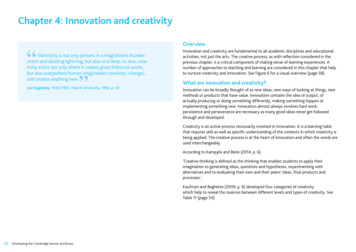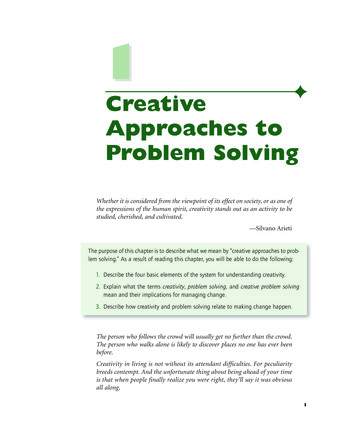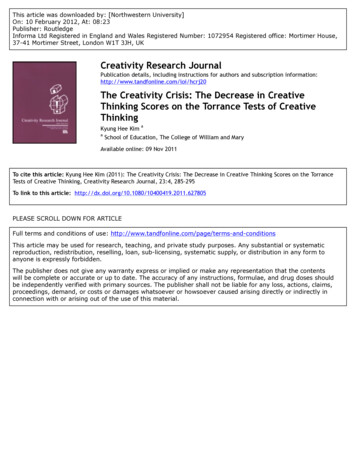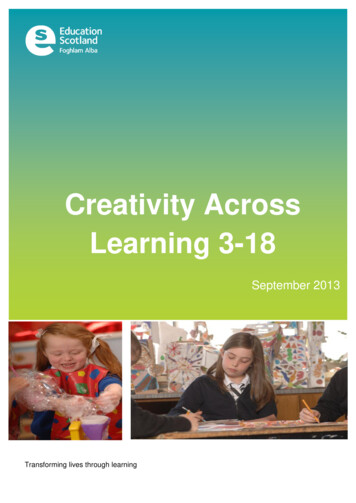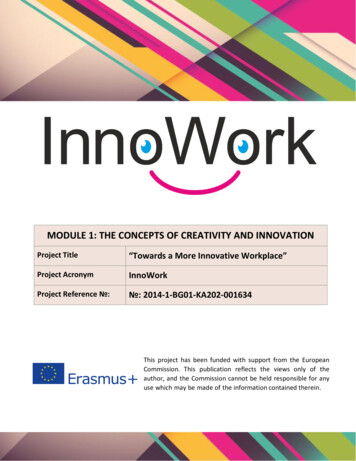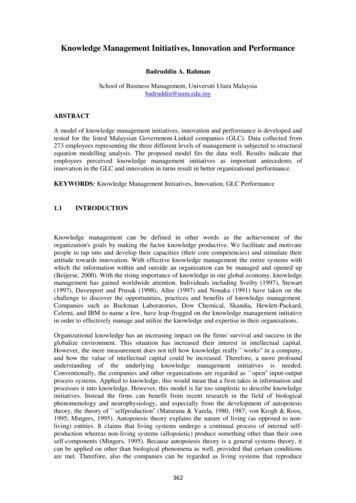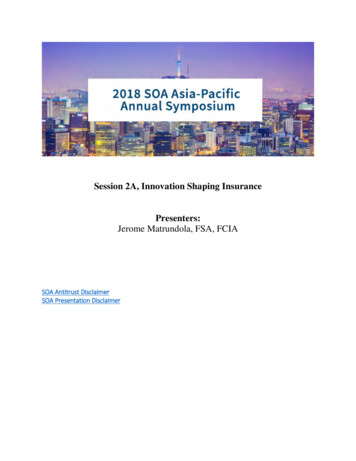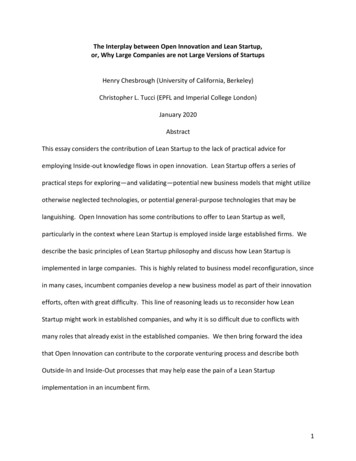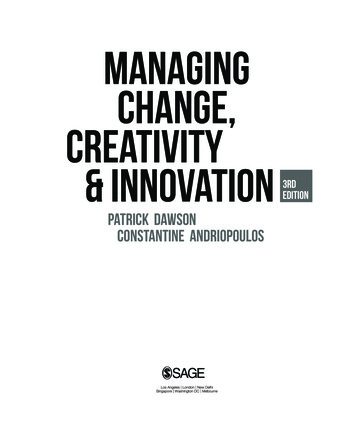
Transcription
ManagingChange,Creativity& Innovation3rdEditionPatrick DawsonConstantine Andriopoulos00 Dawson Andriopoulos Prelims.indd 33/1/2017 5:44:09 PM
SAGE Publications Ltd1 Oliver’s Yard55 City RoadLondon EC1Y 1SPSAGE Publications Inc.2455 Teller RoadThousand Oaks, California 91320SAGE Publications India Pvt LtdB 1/I 1 Mohan Cooperative Industrial AreaMathura RoadNew Delhi 110 044SAGE Publications Asia-Pacific Pte Ltd3 Church Street#10-04 Samsung HubSingapore 049483Editor: Delia Martinez-AlfonsoAssistant Editor: Lyndsay AitkenProduction editor: Sarah CookeMarketing manager: Alison BorgCover design: Shaun MercierTypeset by: C&M Digitals (P) Ltd, Chennai, IndiaPrinted in the UK Patrick Dawson and Constantine Andriopoulos 2017First published 2009. Reprinted 2010, 2011 (twice) and 2012.Second edition published 2014. Reprinted 2014 (three times)and 2015 (twice).Third edition published 2017.Apart from any fair dealing for the purposes of research orprivate study, or criticism or review, as permitted under theCopyright, Designs and Patents Act, 1988, this publicationmay be reproduced, stored or transmitted in any form, or byany means, only with the prior permission in writing of thepublishers, or in the case of reprographic reproduction, inaccordance with the terms of licences issued by the CopyrightLicensing Agency. Enquiries concerning reproduction outsidethose terms should be sent to the publishers.All material on the accompanying website can be printedoff and photocopied by the purchaser/user of the book. Theweb material itself may not be reproduced in its entirety foruse by others without prior written permission from SAGE.The web material may not be distributed or sold separatelyfrom the book without the prior written permission of SAGE.Should anyone wish to use the materials from the website forconference purposes, they would require separate permissionfrom us. All material is Patrick Dawson and ConstantineAndriopoulos 2017Library of Congress Control Number: 2016950615British Library Cataloguing in Publication dataA catalogue record for this book is available fromthe British LibraryISBN 978-1-47396-427-3ISBN 978-1-47396-428-0 (pbk)At SAGE we take sustainability seriously. Most of our products are printed in the UK using FSC papers and boards.When we print overseas we ensure sustainable papers are used as measured by the PREPS grading system.We undertake an annual audit to monitor our sustainability.00 Dawson Andriopoulos Prelims.indd 43/1/2017 5:44:09 PM
10CREATIVE INDUSTRIES, INNOVATIVECITIES AND CHANGING WORLDSI am enough of an artist to draw freely on my imagination. Imaginationis more important than knowledge. Knowledge is limited. Imaginationencircles the world. (Albert Einstein quoted in Viereck, 1929: 117)LEARNING OUTCOMESAfter reading this chapter, you will be able to: Identify and discuss the range of factors that are driving developments towards a newage of creativity. Debate the nature of these developments and their implications for work, employmentand society. Outline and describe the different creative industry subgroups that constitute the newcreative economy. Evaluate the importance of creative industries to national economies and explore thenumber and type of people who are involved in them. Appraise whether the current focus on the industrial and commercial aspects of creative industries is undermining essential creative processes through downplaying theimportance of the more artistic and cultural dimensions.10 Dawson Andriopoulos Ch-10 Part III.indd 3773/1/2017 7:22:42 PM
Understand the changing need for more adaptive forms of organizing and ambidextrous firms. Explain Florida’s 3-T model and discuss the issues and debates around the rise of thecreative class. Assess the importance of creative places (cities, regions, communities, organizations)to creating and sustaining a culture of change, creativity and innovation.INTRODUCTIONCreativity, innovation and change are central to economic competitiveness inadvanced economies and, as a consequence, are high on the agenda of politicians and policy-makers. Several countries pride themselves on being ‘creative’economies that develop, attract and retain creative individuals and nurturecreative organizations (see Florida, 2004, 2012; Florida and Goodnight, 2005).The UK government, for instance, views creative talent as one of Britain’smost distinctive and marketable strengths and proposes that creativity is fundamental to the future health of the UK economy (DCMS, 2016). Encouragingpeople into careers within creative industries has also become an important partof policy, with growing emphasis being placed on strategies that create and support a culture where creativity can thrive, particularly in the development of aneducation system that facilitates the generation and realization of ideas froman early age (Todorovic and Bakir, 2016). In Europe, attention has been givento policies that can support and stimulate developments in the creative economy(UNCTAD, 2008, 2012), and governmental programmes in North America, Canada,Australia, New Zealand, Asia, Latin America, Africa and the Middle East, have allbeen instrumental in promoting and encouraging activities in this ‘new’ and developing sector. Asia-Pacific’s creative economy is the largest (with China and Indiashowing the biggest historical growth), followed by Europe and North America(Florida, 2015). Although a number of creative industries have existed for along while, such as architecture, art and antiques, there is also an emerging anddeveloping range of products and services around, for example, digital entertainment, electronic publication and smart and iPhone applications. In assessing theimportance of creative industries to the UK economy, a government statement in2015 noted that:New figures published today reveal that the UK’s Creative Industries,which includes the film, television and music industries, are nowworth 76.9 billion per year to the UK economy. This massive contribution is an all-time high and equates to 8.8m per hour, or 146,000every single minute, playing a key role in the Government’s long-termeconomic plan. (DCMS, 2015a)The value of creative organizations in the global economy is rising annually, withmore than 50 per cent of economic growth in the twenty-first century coming378Creativity, innovation and change in organizations10 Dawson Andriopoulos Ch-10 Part III.indd 3783/1/2017 7:22:42 PM
from products and services that were only in their infancy or did not exist at all inthe late twentieth century. This new and emerging age of creativity is also aboutthe places and spaces in which creative activities flourish in the home, cafes,organizations, cities and regions. Technological advancement in digital connectivity and new design software and marketing strategies to make new productsand services that stand out from the crowd are becoming increasingly important with more educated, discerning and demanding customers who are able totroll the Web finding best prices and options. The intensity of global competition places pressure on national economies that seek to secure a well-educated,knowledgeable workforce and nurture a raft of creative activities, not only amonglarge business but in the stimulation and growth of small- and medium-sizedenterprises (SMEs) and other innovative entrepreneurial activities. Employees’expectations are on the rise in line with customers and in what Florida (2012)refers to as the new ‘creative class’, there is the pull of place as well as jobs thatis increasingly being called into play in making decisions on where to live. Forexample, in a UNESCO (2015) report they claim that the top cities ranking inglobal talent are New York, London and Paris, stating that:New York – enjoys a unique cultural scene, embedded in a cosmopolitanand forward-thinking urban environment, generally considered beneficialto creative activities. London – ahead of Paris owing to its internationalopenness (33% of its population was born abroad, compared with just12% in Paris). Paris – ranks third due to its cultural heritage and technology assets, but is penalized by a weaker entrepreneurial environment.(2015: 23)Capturing the economic value of creativity (NESTA, 2016) and the disruptiveinnovation of the creative economy (DeFillippi and Wikström, 2014) are subjects that are receiving increasing international attention (UNESCO, 2015). Thischapter aims to shed some light on the emergence and development of the creativeeconomy, creative employment and the creative class, as well as the importanceof creative cities and regions and the need for more adaptable, innovative andambidextrous organizations in encouraging and nurturing creative processes thatpromote the growth of creative industries to secure prosperity in an increasinglycompetitive global market economy.A CREATIVE EPOCH: ENTREPRENEURSHIP,INNOVATION AND AMBIDEXTERITYHartely et al. (2015), in their book Creative Economy and Culture: Challenges,Changes and Futures for the Creative Industries, argue that the rise of creativeindustries represent a new epoch. With previous epochs being represented by thehunter-gatherer era (70,000 years ago), the agricultural era (about 10,000 years ago),the industrial era (from the Industrial Revolution to the twentieth century) and theCreative Industries, Innovative Cities And Changing Worlds10 Dawson Andriopoulos Ch-10 Part III.indd 3793793/1/2017 7:22:42 PM
creative era (arising in the late twentieth century and becoming more prominentin the twenty-first century) that marks a new age tied to developments in information and communication technologies (the internet) and the global networkedsociety. In an early work on creative industries, Caves (2002) examines the contracting relationships between the agents of creative production, distribution andconsumption and creative workers. He argues that, unlike humdrum workers, artists are seen to trade financial rewards for the opportunity to engage in work thatallows self-expression and is autonomous. However, in what may be viewed as anoverly romanticized view of creative work, artistic creativity is privileged over nonartistic creativity and yet it is questionable whether trading away financial return forautonomy is unique to artists. Caves’ (2002) attention remains with higher forms ofartistic endeavour and there is no attempt to examine creative industries linked tothe digital networked economy. In contrast, Handy (2001), in another early piece,was quick to spotlight the capacity for developments in technology to change theway we work and to offer new opportunities for entrepreneurial-minded individuals.Digitalization, low-cost PCs, the World Wide Web (WWW) and information and communication networks were seen to herald the development of seamless simultaneousconnections across countries, regions, organizations, workplaces and homes. Newways of communicating, engaging in social activities and conducting business, allprovide innovative opportunities and open up choices that were previously unavailable. There are a combination of factors that are seen to be at work in driving thesedevelopments from an industrial era towards a new epoch of creativity. These can besummarized as follows:Technology: Rapid technological advancements in ICT, digitalization, newdesign software, mobile media technologies and the extensive use of the Web,have all changed the way we work and live through shifts in communicationpatterns and activities, new systems of electronic administration andgovernance, and our engagement as consumers and producers in an everexpanding digital networked global economy (see Avril and Zumello, 2013;Castells, 2000, 2001; Yates et al., 2017). The early work of Özsomer et al.(1997) forecast the emergence of a new ICT driven business era, a periodwhich has now arrived (see also Ibrahim, 2012; Preece et al., 2000; Youngs,2017). The information revolution has created a business environment withshorter product cycles, increased segment fragmentation and increasedinterdependence of world markets. Such environmental dynamismincreases the need for creativity and change – the ability for organizationsto continuously introduce new products and production processes thatcapitalize on market opportunities. These technological developments havechanged the context of business operations requiring companies to supporta culture of creativity that can nurture and facilitate the generation andrealization of new ideas (see Youngs, 2015).More unpredictable and demanding customers: It is also commonlyaccepted that customers today are more knowledgeable about whatproducts and service are available and, hence, they are becoming more380Creativity, innovation and change in organizations10 Dawson Andriopoulos Ch-10 Part III.indd 3803/1/2017 7:22:43 PM
demanding and less ‘loyal’ to particular brands (Beranek and Kamerschen,2013). Nevertheless, customers still remain at the heart of any organizationand companies need to keep abreast of changing customer requirements(Cockerell, 2013). Demographic changes are also leading to a growingdiversity in the profile of customers (for example, in terms of ethnicity andage), which makes customizing to individual differences essential for gainingand sustaining a competitive edge (see Furseth and Cuthbertson, 2016).Global competition: Global competition is placing competitive pressureon national economies that, whilst promoting the need to identify newopportunities can also serve to constrain the mobilization of ideas andencourage creativity in support of creative industries (see Wagner et al.,2016). For some commentators, creative individuals and firms were at thecentre of a drive to relaunch economic activity following the global financialcrisis (Burger-Helmchen, 2013). With an increasingly global and diversecompetitive market environment fuelled by multimedia developments andthe internet, market knowledge is critical in making decisions and fosteringquick innovations that support a constant stream of new and improvedproducts, processes and services, in order to ensure company survivaland to meet the challenges faced by organizations operating in this globalenvironment (see Cavusgil et al., 2016).Knowledge: The advances in communication and information technologyhelp organizations to learn and compete at a faster pace. Thus, not onlydeveloping and sustaining organizational knowledge, but also ensuring thatorganizational memory is enriched and maintained, are all pivotal prioritiesin today’s competitive marketplace (see Davenport and Prusak, 2000; Hislop,2013). Creativity is based on combining disparate sources of informationand transforming raw data (which many organizations get bogged down with)into valuable insights. Raw facts, data and information are limited unlessthey are translated into an order that makes sense or can be used to createconnections that lead to the development of new concepts/ideas. Over thelast decade, organizations have used a variety of team-based approaches inorder to improve the way in which knowledge is developed, disseminatedand applied in their working environments. Roberts (2015) argues that thereis far more potential for people from different communities and disciplinesto interact and that the dissonance that can occur in bringing these peopletogether can be highly creative. As she notes: ‘Cross-disciplinary work canbe highly creative and lead to knowledge breakthroughs that would not bepossible from within one discipline’ (Ibid.: 87).Change: The rapid technological advancements and the fierce competitionfor market share have contributed to the increasing pace of change inthe business landscape with terms such as ‘paradigm shift’, ‘managing inchaos’, ‘white-water change’, and ‘rapid organizational change’ have allbeen used to draw attention to the rapidity of business sector change (seeBleistein, 2016). The prevailing forces of organizational change, includingCreative Industries, Innovative Cities And Changing Worlds10 Dawson Andriopoulos Ch-10 Part III.indd 3813813/1/2017 7:22:43 PM
globalization, advanced technology and the supply of new products andservices at much faster speeds and lower costs, have all been evident forsome time. For example, in the 1990s, Morgan (1991) and Peters (1997)argued that the world of business had entered a permanent state of fluxin which constant change is the only strategy for survival for both theindividual and the organization. Similarly, Kotter (2012) talks aboutthe rapid-fire nature of change and the eight accelerators necessary tomanage change successfully; whilst Bleistein (2016) argues that changeis coming faster than ever and agility and pace are critical to companysurvival. Organizational survival is seen to rest on a company’s ability toquickly transform market opportunities into tangible bottom-line resultsin response to the rapidity of change (Kotter, 2012). Whilst research andstudies of change have grown substantially (see Boje et al., 2012; Shaniet al., 2012), there remains considerable debate, even over the discrepancybetween what people do and say about change and what they really think(see Burnes and Randall, 2016).Higher employee expectations: Highly skilled employees working withincreative environments increasingly look for autonomy so that they canexercise personal initiative. Such high-calibre employees are extremely jobmobile and require more than monetary compensation from their work (seeFlorida, 2012). In an early piece on creativity, Nishibori (1972) argued thathuman work should always include creativity (the joy of thinking), physicalelements (the joy of physically using the hands and body in working) andsocial aspects (the joy of sharing with colleagues at work, including the ‘ups’and the ‘downs’). More so than ever before, organizations today are requiredto continuously identify ways for motivating, developing and retaining theircreative and talented people (Devine and Styrett, 2014).The importance and dominance of design: In an unpredictable businessenvironment, the need to stand out from the crowd by adding value iscentral (Martins, 2009). Under such intense market conditions, competitiveadvantage can be fostered if companies see design as an integral part ofbusiness strategy (Carlopio, 2013; Solis, 2015).These trends drive organizations to be more entrepreneurial and innovative inchanging from stabilized bureaucratic forms to more adaptive modes of organizing that are better suited to meet the changing needs of existing and futurepotential customers. Entrepreneurship is central to these processes in whichpeople work together in pursuing entrepreneurial opportunities without beingoverly constrained by existing structures or the resources at hand (Barringerand Ireland, 2006; Zahra et al., 2006). Risks generally accompany entrepreneurial activities in the pursuit of profit (commercial entrepreneurial activity),or social well-being (through social entrepreneurial activities), in the starting ofa new business or in developing new products, processes or services (Schramm,2006). Entrepreneurs are change agents who constantly scan for new opportunities and then bring together the necessary resources required to exploit them.382Creativity, innovation and change in organizations10 Dawson Andriopoulos Ch-10 Part III.indd 3823/1/2017 7:22:43 PM
If successful, they not only create value for themselves, but also for society(for example, in creating employment opportunities). Although many new ventures or corporate innovations fail, some achieve spectacular success (see ourspotlight on Amazon in Case 10.1 that follows).Case 10.1Entrepreneurial flare and the success of AmazonAmazon’s entrepreneurial orientation (the world’s largest online retailer) encourages and supportscontinuous product innovation. Jeff Bezos (the founder and CEO of Amazon.com) first got theidea to start an internet enterprise in 1994. While browsing the internet in search of new venturesfor D.E. Shaw and Co. to invest in, he came across a report noting that the internet was growingby 2000% a month. He drew up a list of 20 potential products that he thought could be sold online,including software, CDs and books.After doing more research with the different product categories in the list, books became theobvious choice for three reasons. First, the book retail market was rather fragmented, with massiveinefficiencies in its distribution system. Second, the absolute number of titles in existence was alsoan issue. Bezos realized that, while even the largest superstores could stock only a few hundredthousand books, a ‘virtual’ bookstore could offer millions of titles. Third, books represented a perfectcommodity since they were identical regardless of where a consumer bought them. Bezos passedup a fat bonus and, together with his wife and their dog, headed for Seattle. With 1 million raisedfrom family and friends, Bezos rented a house in Seattle and almost for a year, he and a crew of fiveemployees worked out of the garage, delving deeper into how to source books and set up a computer system that would make Amazon.com easy to navigate. In July 1995, Amazon.com opened its‘virtual doors’, with more than 1 million titles to choose from. Fuelled by word of mouth, a massiveselection of books, superior customer service and a user-friendly website, the orders started comingin. By September 1996, Amazon.com had grown into a company of 100 employees, with more than 15.7 million in sales. Within the next three years, Amazon.com grew to more than 3000 employeesand more than 610 million in sales.The visionary Bezos started thinking about expanding Amazon.com’s product lines and, in March1999, launched amazon.com Auctions, a Web auctions service. Today, Amazon.com’s product linesinclude books, music CDs, videotapes and DVDs, software, consumer electronics, kitchen items,tools, garden items, toys and games, apparel, sporting goods, gourmet food, jewellery, health andpersonal-care items, beauty products, industrial and scientific supplies and groceries among others.In November 2007, Amazon launched Amazon Kindle, an e-book reader with more than 850,000titles. In September 2011, Amazon announced its entry into the tablet computer market by introducing the Kindle Fire, which runs a customized version of the Android operating system. In April 2015,Seattle-based Amazon launched Amazon Business a new platform aimed at business customers.Amazon continues to stand as a leading global e-retailer with electronic, media devices and associated services generating the bulk of the company’s revenue which amounted to US 107 billion in net(Continued)Creative Industries, Innovative Cities And Changing Worlds10 Dawson Andriopoulos Ch-10 Part III.indd 3833833/1/2017 7:22:43 PM
(Continued)sales in 2015. Jeff Bezos is a very successful entrepreneur who has pursued continuous innovationin his quest to create value through new products and services. Amazon.com’s innovation journeyshows us how a company can pursue different types of innovations – incremental (for example,minor improvements to the website) and radical (for example, launching its own hardware devices –Kindle, Fire, Fire HD, Amazon Business).Questions1. How important is Jeff Bezos (the founder and CEO of Amazon.com) to the spectacular successof this company?2. How exemplary is Amazon to this new creative era, and what are the characteristics of Amazonthat mark the company as a truly innovative and creative company of the twenty-first century?3. In your opinion, what are the major potential pitfalls to the continuing success of this company,and how would you set about making sure that strategies were in place to accommodate sucheventualities?It is not only the success of entrepreneurial activity in creating large global corporations but also entrepreneurial activities that support the creation of SMEs thatmake a significant contribution to employment growth and economic prosperity.Creative entrepreneurs who are able to use technology and other resources intransforming their ideas into new creative services and products are on the rise andare increasingly being recognized as central to promoting innovations and wealthin both industrialized and newly developing economies. In the small, medium andlarge organizations, these innovative and entrepreneurial activities often involvemanaging uncertainty, paradox and tension in ensuring a level of ambidexterityto secure forms of exploitative and explorative innovation (Tushman and O’Reilly,1996). Exploitation refines and extends current knowledge, looking for greaterefficiency and improvements to enable incremental innovation (Atuahene-Gima,2005); whereas, exploration involves the development of new knowledge, experimenting to foster the variation and novelty needed for more radical innovation.In managing the exploration and exploitation tensions, two main forms ofambidexterity are required. First, organizational ambidexterity which signifiesa firm’s capability to manage simultaneous, yet contradictory knowledge management processes, exploiting current competencies and exploring new domainswith equal dexterity (Lubatkin et al., 2006). Related research suggests multiplepaths to ambidexterity. Theories of architectural ambidexterity propose dualstructures and strategies, differentiating efforts to focus on either exploitative orexploratory innovation (Gupta et al., 2006). For example, when the newspaperUSA Today faced the emerging threat of online news media, it set up a new unit,which was more or less independent from the print one (O’Reilly and Tushman,2004). Yet, some important functions were integrated at the top through joint384Creativity, innovation and change in organizations10 Dawson Andriopoulos Ch-10 Part III.indd 3843/1/2017 7:22:43 PM
editorial meetings and top management teams. Further integration was achievedby incentivizing both senior teams (print and online) to accomplish joint goalsrather than to limit their focus to their unit performance only, and by initiatingweekly meetings of lower-level editorial staff. These interactions among seniormanagers and employees between these different units allowed for a range ofsynergies to be achieved.Second, contextual ambidexterity, which in contrast, emphasizes behaviouraland social means of integrating exploitation and exploration (Andriopoulos andLewis, 2009, 2010; Birkinshaw and Gibson, 2004). Socialization, human resourceand team-building practices, for instance, foster shared values and aid coordination, helping actors think and act ambidextrously on a daily basis (Ghoshaland Bartlett, 1997). A study by Gotsi and colleagues (2010) within New ProductDesign (NPD) consultancies showed how many of the employees intervieweddescribed themselves as ‘practical artists’ – a creative working for a business.Perceiving themselves as very creative, yet allowing them to understand the constraints of the business environment can ease their frustrations and help them toavoid costly mistakes.Case 10.2Creative creativity: incremental and radical innovations in Apple Inc.Apple is a great example of an ambidextrous company that manages incremental and radicalinnovations in sustaining their competitive market position. Most innovations tend to be incremental. They build on existing knowledge and provide small improvements in the current product lines(Hill and Rothaermel, 2003). The markets for incremental innovations are well defined, the productcharacteristics are well understood, profit margins tend to be lower and production technologiesare efficient (Jansen et al., 2006). In terms of incremental innovations, Apple continually improvesits iPhones and each new launch has continued to generate significant customer demand andinterest. In contrast to incremental innovations, radical innovations usually provide substantialtechnological breakthroughs and create new knowledge (Ahuja and Lampert, 2001). Creativity interms of discovering, combining or synthesizing current knowledge (often from a diverse range ofareas) is required to develop radical innovations (Sutton, 2002). The generated knowledge fromthis difficult and risky process comprises the basis for developing new products that capture newmarkets and gain access to new resources (Sidhu et al., 2007). For example, while Apple focusedon maximizing sales from its current cutting-edge computers (for example, Mac), it also had several teams with different time horizons working on different innovations.In 2001, Apple entered the consumer electronics market by introducing its first iPod, which becamesynonymous with the MP3 music player product category. Praised for its sleek design and equippedwith an easy-to-use menu, the iPod could hold 1000 songs with a battery life of 10 hours. By the endof 2003, more than 1 million iPods were sold; a substantial and new stream of revenues (apart from(Continued)Creative Industries, Innovative Cities And Changing Worlds10 Dawson Andriopoulos Ch-10 Part III.indd 3853853/1/2017 7:22:43 PM
(Continued)its computers). Since then, the iPod product range has been regularly renewed and, in 2007, thecompany announced that it had sold its 100-millionth iPod, which made it the fastest-selling musicplayer in history. A related revolutionary innovation that helped iPod’s outstanding performance interms of sales was the launch of the iTunes music store in 2003, where consumers could buy onlinemusic for 0.99 per song or videos that displayed in the newest versions of iPods.In 2016, Apple remained the world’s largest IT company by revenue and total assets (althoughdisappointing earnings and a historic decline in Apple stock was discussed in May on: c-slide/vi-BBsxFuS). Nevertheless, in 2016, Apple had475 retail stores in 17 countries and, in the first quarter of 2014, earned more than Google, Facebookand Ama
Creativity, innovation and change are central to economic competitiveness in advanced economies and, as a consequence, are high on the agenda of politi-cians and policy-makers. Several countries pride themselves on being ‘creative’ economies that dev
